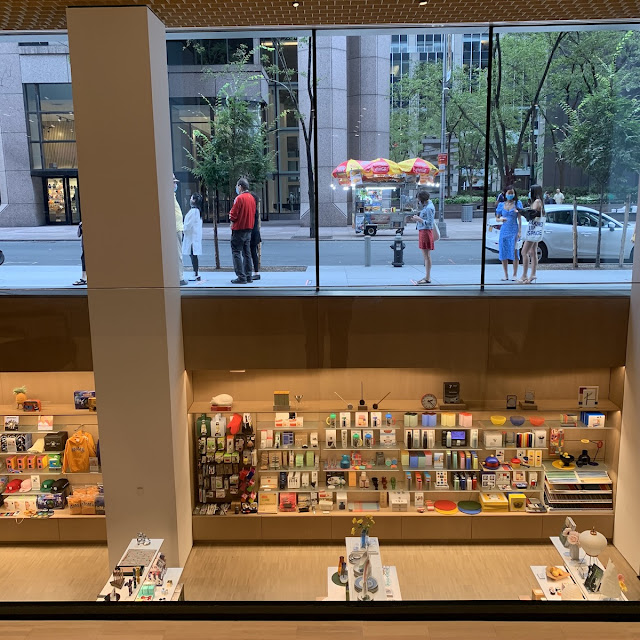MoMA in Masks
Update. Beginning September 28, MoMA will require all members to reserve tickets in advance.*
Walking into the gallery devoted to Claude Monet’s Water Lilies (c 1920) at the Museum of Modern Art (MoMA) on Saturday afternoon, I saw a woman seated on a bench. She was looking at the artist’s dreamy depiction of his garden at Giverny, and I thought for a moment she might be dreaming as well. As she was the only person occupying what is usually a packed room for fans of Impressionism, I was hesitant to invade her private garden reveries.
 |
| At MoMA |
I would enjoy my own such private moments with my favorite MoMA works that afternoon, including Marc Chagall’s I and the Village (1911). The painting depicts a colorful and geometric fairy tale of peasants and animals, memories of the artist’s childhood home outside Vitebsk. And I had a long time to feel the scorching sun of photographer Dorothea Lange’s Woman of the High Plains, Texas Panhandle (1938), a setting closer to my hometown. Later I would sit in the dappled sunlight and quiet of the museum’s Sculpture Garden, enjoying Auguste Rodin’s formidable Monument to Balzac (1897-98), Pablo Picasso’s She-Goat (1950s), and one of Donald Judd’s untitled painted steel works from 1968, among others. I would spend more time with Judd later on the sixth floor.
 |
| View of the gift shop and the line to enter outside on W. 53rd Street |
But, first, there was the temperature check. Going to MoMA, much like any museum in the city that has reopened this past month, takes a bit of pre-planning. In most cases, a museum visit requires the purchase of a pre-timed advance ticket. You can’t just waltz into a museum like in the pre-pandemic days. MoMA, as an exception, allows its members to just show up during museum hours (with Mondays reserved exclusively for members and their guests) and get in line.* (see update note at top - MoMA has changed its policy and will require members to reserve timed tickets as well.) When I arrived in the early afternoon on Saturday, the line was short and swift. When I left, the line stretched back to Sixth Avenue.
 |
| At MoMA |
The next step was the temperature check, which I managed to pass, allowing me to advance to the next checkpoint where I showed my membership card. Some information was shared, including the suggestion that I take a phone picture of the exhibition display board if I wanted to know how to find my way around. There’s no printed literature or map or anything touchable. The restaurants are closed and the drinking fountains are turned off. The bathroom facilities are from the future, so I wasn’t sure how everything worked. The gift shops, if you’re worried, are completely open and accessible.
 |
| In the Sculpture Garden with Pablo Picasso's She-Goat six feet away. |
Visiting an art museum stripped to its bare essentials does have a way of directing attention to the actual art, especially if everyone is forced to keep their distance. The new MoMA, barely reopened when it was forced to shut down again in the pandemic, has been greatly expanded. With a limit on the number of hourly visitors, the space has seemed to grow exponentially, taking on the feeling of a place like MassMoCA or Dia:Beacon, both converted manufacturing sites. Yet, MoMA has renewed its purpose in presenting and re-presenting a coherent multi-media story of the history of modern art in more intimate ways.
 |
| Judd |
The Judd exhibit, on display through January 9, 2021, especially benefits from the lack of crowds. His works need room to breathe. Moving from handcrafted objects to industrial fabricated ones, the “stacks” and “progressions” were conceived as works to engage with space and specific rooms. He later investigated colors in new objects of aluminum. While repetitious and conceived without the intrusion of an artistic personality, the works take on rhythm and a visual power. While looking at one of the “stacks” from 1968, I was reminded of the monolith from 2001:A Space Odyssey, a film from that same year.
 |
| The scene early Saturday afternoon on W. 53rd Street outside MoMA |
Who knows how long MoMA and the other museums stay in pandemic mode? For the sake of the museum and the city, we want the visitors to come back. In the meantime, now may be an excellent time for New Yorkers to study the history of art.
The Museum of Modern Art (MoMA) reopened to the public on August 27, with new hours for the first month, through September 27: from 10:30 a.m. until 5:30 p.m. Tuesday through Sunday to the public; and from 10:30 a.m. until 5:30 p.m. on Mondays for MoMA members only. Admission will be free to all visitors Tuesday through Sunday, through September 27, made possible by UNIQLO.
Images from Saturday, September 12, 2020.





Comments
Post a Comment